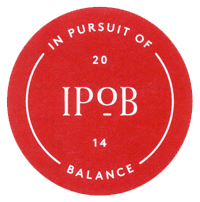Anthill Farms Winery
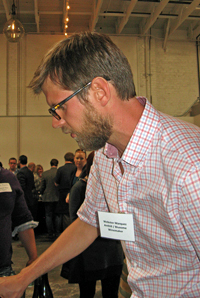 |
Anthill Farms 2011 Pinot Noir, Comptche Ridge Vineyard, Mendocino County. Mostly from Swan selection. Fairly light ruby color, this showed aromas of black cherry and raspberry, with lots of spice and touches of earth and flowers. Medium-light weight with a lively texture and moderate tannins on the finish, very tasty now and should age well too.
Anthill Farms 2012 Pinot Noir, Sonoma Coast. Sourced from Campbell Ranch near Annapolis and Hurst Vineyard near Sebastopol. Medium-light color, with a somewhat riper fruit profile than the first wine, displaying more intense black cherry character plus earthy and herbal notes. Mouth-watering acidity on the palate with a bright finish, nice.
Anthill Farms 2012 Pinot Noir, Campbell Ranch Vineyard, Sonoma Coast. From 14-year old vines on Goldridge soil, fermented with about 30-40% whole clusters. Medium-light color, this showed the herbal, slightly stemmy whole-cluster character along with spice, forest floor, and plum fruit more in the background. Bigger mouthfeel than the first two Pinots, with a rounder texture and more noticeable tannin on the finish, this needs time in the cellar.
Comments: Anthill Farms was established in 2004 by three partners – Webster Marquez, David Low, and Anthony Filiberti – who had first met while working at Williams-Selyem Winery in Russian River Valley. Known as a Pinot Noir specialist, they focus on Anderson Valley and the Sonoma Coast. They also produce smaller amounts of Chardonnay and Syrah. Webster poured the wines at the event, and all three Pinots were very good.
Bluxome Street Winery
Bluxome Street 2012 Chardonnay, Teac-Mor Vineyard, Russian River Valley. Very light straw color, with ripe stone fruit and tropical fruit aromas plus notes of baking spice and vanilla/oak. Medium-light bodied with lively acidity and a clean finish.
Bluxome Street 2012 Pinot Noir, Hurst Vineyard, Russian River Valley. Medium-light ruby color, this displayed red fruits, herbs, earth, and vanilla/oak on the nose. Medium weight on the palate, with fairly mild tannins.
Comments: The host of the past two San Francisco IPOB events, Bluxome Street Winery is relatively new on the scene, with just a few vintages produced so far. Partners Matt Reidy and Peter Chouinard run the operation, while Anthill Farms’ Webster Marquez is their winemaker.
Calera Wine Company
Calera 2012 Chardonnay, Mount Harlan. Whole-cluster pressed and aged for ten months in 30% new French oak. Very light color, featuring lots of spice upfront, along with pear and stone fruit, lemonpeel, and sweet oak. Medium-bodied with bright acidity in the mouth, and a chalky texture on the finish, nice.
Calera 1999 Chardonnay, Mount Harlan. Light yellow/gold color, with more muted apple, dried herb, and spice aromas. Richer texture on the palate, with a smoother finish.
Calera 2011 Pinot Noir, Ryan Vineyard, Mount Harlan. From the youngest and most densely-planted of the Calera estate vineyards on Mount Harlan, first planted in 1998. 100% whole-cluster fermentation, aged for 18 months in 30% new French oak. Light ruby color, this showed bright cranberry and spice aromas, plus earth, tea leaf, and touches of flowers and vanilla/oak. Medium-bodied and bright, with lots of structure but surprisingly tame tannins on the finish – all the components are integrating quickly and this is already quite nice though it should age beautifully.
Calera 1997 Pinot Noir, Jensen Vineyard, Mount Harlan. Light brickish color, with cherry, tea leaf, earth, and baking spice aromas. Still youthful and quite tannic, this should continue to age well for years to come.
Comments: Josh Jensen first planted vines in the limestone soil of Mount Harlan in San Benito County in the 1970s, and his Pinots in particular have been among California’s most distinctive over the years. The vineyard ranges up to 2,500 feet in elevation and is organically-farmed. All of the wines are fermented with native yeast. As usual, Josh poured his wines at the tasting. It’s always interesting to taste older vintages of Calera wines, and it was generous of Josh to pour some at IPOB. Both new releases showed very well.
Ceritas Wines
Ceritas 2012 Chardonnay, Charles Heintz Vineyard, Sonoma Coast. From a vineyard just east of Occidental, with vines planted in 1980. Very light straw color, displaying bright citrus and fresh herb aromas along with a touch of earth. Medium-light bodied with juicy acidity and a chalky mineral note on the finish, nice.
Ceritas 2012 Chardonnay, Porter-Bass Vineyard, Sonoma Coast. From biodynamically-farmed 30-year Old Wente clone vines. Light color, this had pear and stone fruit and lots of spice on the nose. Richer mouthfeel and a bolder finish than the first wine but still with fresh acidity running through it.
Ceritas 2012 Pinot Noir, “Costalina,” Sonoma Coast. Sourced from two vineyards. Light ruby color, with tart cranberry, tea leaf, and spice aromas. Medium-light weight on the palate with a moderately tannic finish.
Ceritas 2012 Pinot Noir, Hacienda Secoya Vineyard, Anderson Valley. The vineyard is in the “Deep End” of Anderson Valley, with Pommard clone vines planted in 1995. Medium-light color, black cherry and raspberry fruit plus earth, tea leaf, and a savory note. More structured than the “Costalina” with great texture and firm tannins on the finish – only beginning to show its potential but very promising.
Ceritas 2012 Pinot Noir, Hellenthal Vineyard, Sonoma Coast. From own-rooted Calera vines in a separate block planted in 1980 by David Hirsch not far from his own vineyard. Medium-light ruby color, this showed black cherry fruit, fresh herbs, a touch of forest floor, as well as a savory streak not unlike the previous wine. Richer mouthfeel with plenty of structure for aging, and finishing with fairly grippy, chalky tannins, nice.
Comments: John Raytek and his wife Phoebe Bass founded Ceritas in 2005, and the focus has been mainly on Sonoma Coast Chardonnay and Pinot Noir. Phoebe’s family owns Porter-Bass Vineyard, located near Forestville. All of the wines are made in older cooperage. John and Phoebe were both on hand to pour their wines at the tasting. All of the wines were excellent, and it was tough to pick favorites among them.
Chanin Wine Company
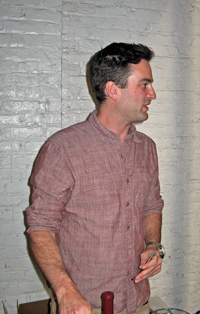 |
Chanin 2012 Chardonnay, Los Alamos Vineyard, Santa Barbara County. Barrel-fermented in 15% new French oak. Very light straw color, with bright lemon and spice aromas plus touches of lees, earth, and oak. Medium-light bodied with a clean, crisp mouthfeel and finish, nice.
Chanin 2012 Chardonnay, Bien Nacido Vineyard, Santa Maria Valley. Sourced from 39-year old vines, barrel-fermented in 30% new French oak. Very light color, this showed apple and pear fruit, baking spice, and slightly toasty oak. Bigger on the palate than the previous wine but still lively and fresh.
Chanin 2012 Chardonnay, Sanford & Benedict Vineyard, Sta. Rita Hills. Barrel-fermented in 25% new French oak. Very light color, displaying more high-toned green apple character along with spice, lees, and herbs. Medium-rich mouthfeel with a slightly rounder texture and smooth finish.
Chanin 2012 Pinot Noir, Los Alamos Vineyard, Santa Barbara County. From 115 and 777 clones, aged in 20% new French oak. Medium-light ruby color, featuring cranberry and strawberry fruit, tea leaf, spice, and a slight orangepeel note. Lighter-bodied with bright acidity and a clean finish – nice already but should benefit from time in the cellar too.
Chanin 2012 Pinot Noir, La Rinconada Vineyard, Sta. Rita Hills. Barrel-aged in 25% new French oak. Slightly darker color, this showed a darker fruit profile of plum and darker berries, along with a bigger spice component. Richer mouthfeel with good structure and firm tannins.
Comments: Chanin Wine Company was founded by Gavin Chanin in 2007. He has been making a single Chardonnay and Pinot from two Santa Barbara County vineyards each year. Current wines are sourced from some of the oldest plantings in the region. Chardonnays are whole-cluster pressed to tank but not settled before they’re racked to barrel and aged on the lees for up to 14 months. There is generally some whole-cluster fermentation on the Pinots but this varies by vineyard and vintage. Gavin poured a strong line-up again at IPOB this year.
Cobb Wines
Cobb 2010 Pinot Noir, Coastlands Vineyard, Sonoma Coast. From Pommard, Martini, Wädenswil, and Mount Eden clones, aged in 40% new French oak. Medium-light ruby color, displaying tea leaf, forest floor, and spice aromas upfront with strawberry, flowers, and a touch of sweet oak in support. Medium-light bodied with a lively texture and a long finish with mildly chalky tannins, nice.
Cobb 2009 Pinot Noir, Joy Road Vineyard, Sonoma Coast. Aged in 35% new French oak. Medium-light garnet, this was somewhat closed at first and took some aeration to open up, with aromas of tart cherry and herbs, and hints of mushrooms and wet stones. More structured on the palate, with a firmer tannic finish – this has potential but needs more time.
Cobb 2008 Pinot Noir, Jack Hill Vineyard, Sonoma Coast. Aged in 35% new French oak. Medium-light color, this showed black cherry and raspberry fruit plus hints of dried herbs, earth, and baking spice. Medium-bodied, a stony mineral note came out in the mouth, and the finish featured grippy tannins.
Comments: Ross Cobb (who also makes the wines for Hirsch Vineyards) was behind the table at the tasting. Joy Road and Coastlands (Cobb’s estate vineyard) are located near Occidental, while Jack Ridge is closer to Freestone. Ross’ parents David and Diane first planted Coastlands Vineyard in 1989, and David and Ross established the Cobb label in 2001.
Domaine de la Côte
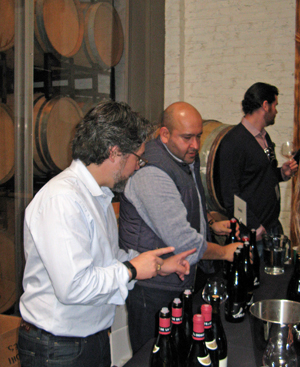 |
Domaine de la Côte 2011 Pinot Noir, Sta. Rita Hills. Fermented with 50% stem inclusion, aged in 15% new oak. Medium-light color, with stemmy/herbal aromas upfront, followed by tart red fruit, earth, and spices. Medium-bodied and lively on the palate, finishing with moderate tannins.
Domaine de la Côte 2011 Pinot Noir, Bloom’s Field, Sta. Rita Hills. From Mount Eden, Swan and Calera selections, fermented with 90% stem inclusion. Slightly darker color, this featured more forward black cherry fruit, along with dried herbs, baking spices, a chalky mineral note, and a touch of sweet oak. More structured than the first wine, with bright acidity and firm but refined tannins, nice now and should age well.
Domaine de la Côte 2011 Pinot Noir, La Côte, Sta. Rita Hills. Fermented with 100% stem inclusion. Medium-light color, this was similar to the first wine in the prominent stemmy/herbal character, while the darker fruit profile and chalky note recalled the Bloom’s Field bottling. Bigger on the palate, this had a grippy tannic finish and will need cellar time to round out.
Comments: Domaine de la Côte grew out of the Evening Land project – Raj Parr and Sashi Moorman are part of a group who purchased it in early 2013. Sashi and Chris King first developed the vineyard sites for Evening Land in 2007, and they’re planted at high vine densities entirely to California heritage Pinot selections. The wines are produced in Lompoc and the three 2011 Pinots poured at IPOB are the winery’s first releases. Sashi was on hand to pour at the tasting.
Drew Family Cellars
Drew 2012 Pinot Noir, Weir Vineyard, Yorkville Highlands. Weir Vineyard is at higher elevation, planted in the 1990s. From Rochioli and DRC selections and 2A clone, 33% whole-cluster fermentation. Light garnet color, this had red fruits, herbs, and earth, along with a touch of sweet oak. Medium bodied with moderate tannins on the finish.
Drew 2012 Pinot Noir, Morning Dew Vineyard, Anderson Valley. From a vineyard in the “Deep End” of the valley nearest the coast, planted in 2001 by Burt Williams. Rochioli and La Tâche selections, 30% whole-cluster fermentation. Slightly darker ruby color, featuring expressive aromas of strawberry and red cherry, exotic spices, tea leaf, and hints of flowers. Medium weight with good structure and a lively texture, finishing with chalky tannins, nice.
Drew 2012 Pinot Noir, Valenti Vineyard, Mendocino Ridge. The vineyard is on Greenwood Ridge, about six miles from the ocean. From 667 and Rochioli clones, fermented with 50% whole clusters. Medium-light color, with cranberry, forest floor, dried herb, and stony mineral notes, plus a bigger spice component. Bigger on the palate but nicely balanced, with a firm tannic finish – a promising youngster that will need time in the cellar.
Drew 2012 Pinot Noir, Balo Vineyard, Anderson Valley. A new single-vineyard bottling for Drew, the vineyard is just outside the town of Philo and is planted to 115, 777, 828, Martini, and Pommard clones. 20% whole-cluster fermentation. Medium-light ruby, showing black cherry, spice, and earth on the nose. This had a somewhat richer texture but with plenty of structure for aging and grippier tannins on the finish.
Comments: Jason and Molly Drew launched Drew Family Cellars in Santa Barbara County in 2000, In 2004, they purchased a property on a 1,300-foot ridgetop west of Anderson Valley, and they’ve focused mostly on fruit sources from Mendocino County ever since. The Drews planted their own estate vineyard in 2011 with eight clones of Pinot Noir – they’re located only about three miles from the ocean in the Mendocino Ridge AVA. Pinots are fermented with varying amounts of whole clusters and are started with native yeasts, and are aged in French oak for 11-18 months. Jason poured his wines at IPOB, and he presented a group of very distinctive Pinots.
Failla Wines
Failla 2012 Chardonnay, Sonoma Coast. From younger vines, about half the fruit was fermented in concrete egg and stainless steel, and half in French oak, 15% new. Light straw color, this had a pear and apple fruit profile along with touches of spice and lemonpeel. Medium-light weight with vibrant acidity and a chalky mineral character on the finish.
Failla 2012 Chardonnay, Haynes Vineyard, Coombsville. From Wente clone vines planted in 1966 and dry-farmed, barrel-fermented with 33% new French oak along with some concrete egg fermentation. Light color, featuring more intense aromas of pear, herbs, and a touch of toasty oak. Richer on the palate than the previous wine, but still with juicy acidity and a clean finish, nice.
Failla 2012 Pinot Noir, Sonoma Coast. Made from maturing vines sourced from various vineyards (including Hirsch and Keefer Ranch), aged in about 20% new oak. Medium-light ruby color, this had an earthy, forest floor character along with spice and cherry fruit. Medium-light bodied with moderate tannins on the finish.
Failla 2012 Pinot Noir, Keefer Ranch, Russian River Valley. Destemmed, and aged in 33% new oak. Slightly darker color, showing raspberry and black cherry fruit upfront, along with spice, tea leaf, and earth. Richer than the previous wine but with vibrant acidity and texture on the palate and fine, chalky tannins on the finish, nice.
Failla 2012 Pinot Noir, Savoy Vineyard, Anderson Valley. A new bottling for Failla. Medium-light color, this displayed plum and darker fruits on the nose, along with a brushy forest floor note and lots of spice. Big and structured with a grippy tannic finish, this has potential but will need time in the cellar to show its best.
Comments: Originally called Failla Jordan, the winery was founded in 1998 by winemaker Ehren Jordan and his wife Anne-Marie Failla. Their first Pinot was a Keefer Ranch bottling from the 1999 vintage, and Chardonnay followed shortly afterwards. They first planted their estate vineyard in 1998 – it’s located on the far Sonoma Coast not far from Marcassin, Flowers, and Hirsch in the recently-designated Fort Ross-Seaview AVA. Pinot has been the core of the Failla production over the years, with bottlings continuing from Keefer Ranch and other cooler-climate sources, mostly from the Sonoma Coast. Ehren was on hand to pour his wines at the tasting, and the wines were strong across the board.
Flowers Vineyard & Winery
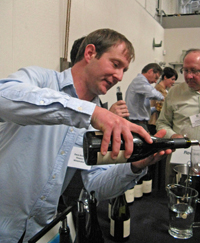 |
Flowers 2011 Chardonnay, Sonoma Coast. Sourced from several vineyards including 20% estate fruit, 80% barrel-fermented and 20% tank-fermented, aged in 18% new French oak. Medium-light straw color, this featured bright citrus fruit and touches of flowers and toasty oak. Medium-light weight with a vibrant mouthfeel and a stony mineral note on the crisp finish.
Flowers 2011 Chardonnay, Camp Meeting Ridge, Sonoma Coast. From 20-year old vines, barrel-fermented in 45% new French oak. Light straw color, with pear and lemonpeel aromas plus spice and vanilla/oak in support. Richer mouthfeel than the first wine but retaining both the fine acidity and bright, minerally finish, nice.
Flowers 2011 Pinot Noir, Sonoma Coast. About 5% whole-cluster fermentation, aged in 25% new oak. Light ruby color, showing earth and dried herbs up front, with red cherry and spice in the background. Medium-bodied with and lively on the palate with a bright, tingly finish.
Flowers 2011 Pinot Noir, Sea View Ridge, Sonoma Coast. From 777, 828, Calera, and Swan clones, 10% whole-cluster fermentation, aged in 30% new French oak. Medium-light color, with pretty floral aromas along with red fruits, tea leaf, and baking spices. Medium-bodied with a silky texture and a chalky mineral quality on the long finish, nice.
Comments: Walt and Joan Flowers began planting Chardonnay and Pinot Noir at their remote Camp Meeting Ridge Vineyard northwest of Cazadero (in what’s now the Fort Ross-Seaview AVA) in 1991, and Sea View Ridge Vineyard was planted nearby about 8-10 years later. Winemaker Dave Keatley poured at IPOB – he’s been part of the Flowers winemaking team since 2008. This was a fine line-up which demonstrated again that the difficult 2011 vintage produced some outstanding wines.
Hanzell Vineyards
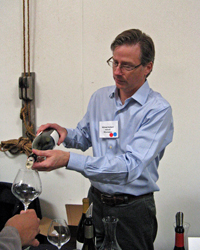 |
Hanzell 2012 Chardonnay, “Sebella,” Sonoma Valley. Made from younger vines (about seven years old), fermented in stainless steel and aged in older oak, with no malolactic fermentation. Light straw color, with ripe apple, floral, and spice aromas. Medium-bodied, the round texture contrasted with bright acidity, and the finish was clean and fresh.
Hanzell 2010 Chardonnay, Sonoma Valley. From 37 year-old vines, barrel-fermented in 30% new French oak. Medium-light color, this featured apple and citrus zest, spice, floral notes, and toasty oak on the nose. Richer, creamier texture than the previous wine, but still with fine acidity and a long, lively finish, nice.
Hanzell 2010 Pinot Noir, Sonoma Valley. Medium-light ruby color, the aromas displayed raspberry and black cherry, earth, tea leaf, baking spices, with a background of vanilla/oak. Medium weight on the palate with a fairly round but lively mouthfeel and a tasty finish with refined tannins, nice.
Comments: The winery was founded in 1957 by James D. Zellerbach, who had begun planting Chardonnay and Pinot Noir in the Mayacamas Mountains above Sonoma Valley in 1953 with cuttings from Martin Ray’s vineyard in the Santa Cruz Mountains. The remaining blocks of 1953 vines are said to be the oldest continuously-producing Chardonnay and Pinot noir vines in the country. Ownership of Hanzell has changed a couple of times but has been in the de Brye family since 1975. This was Hanzell’s first appearance at IPOB, and Michael McNeill, who has been Hanzell’s winemaker since 2008, was on hand to pour the wines.
|
Hirsch Vineyard and Winery
Hirsch 2012 Chardonnay, Estate, Sonoma Coast. Barrel-fermented in about 15% new French oak. Light color, with pear and nectarine fruit, spice, a touch of vanilla/oak, and a stony mineral note. Medium weight with a bright mouthfeel and clean finish, nice.
Hirsch 2011 Pinot Noir, “San Andreas Fault,” Estate, Sonoma Coast. Meant to present an overall picture of the estate vineyard, this includes both old and young vines from 27 vineyard blocks. Light ruby color, showing both red and black fruits, a prominent earthy element, a touch of flowers, and lots of spice on the nose. Medium-bodied with great acidity and refined tannins, showing nicely now and has the structure to age well.
Hirsch 2011 Pinot Noir, “Reserve,” Estate, Sonoma Coast. A selection of barrels from old-vine fruit, aged in 40% new French oak. Medium-light color, this was more fruit-forward than the previous wine, with a somewhat darker profile and with bigger spice and vanilla/oak components. Bigger and more structured than the “San Andreas Fault” bottling, with grippier tannins on the finish – this clearly needs time in the cellar.
Comments: David Hirsch was one of the wine pioneers of the western Sonoma Coast, first planting his vineyard only about three miles from the ocean in 1980. The vineyard, scattered among hillsides and ridgetops above the fog line, is planted mostly to Pinot Noir along with a little Chardonnay, with many of the current vines dating form the early 1990s. The vineyard is being converted to biodynamic farming. Ross Cobb has been making the wines since the 2010 vintage. I spotted David and his daughter Jasmine at IPOB, though neither were at their winery table when I stopped by. Their Chardonnay was especially distinctive.
Knez Winery
Knez 2011 Chardonnay, Demuth Vineyard, Anderson Valley. Light straw color, displaying citrus, fresh herbs, hints of lees and oak spice, and a stony mineral note on the nose. Bright mouthfeel with a crisp, clean finish, nice.
Knez 2011 Pinot Noir, Demuth Vineyard, Anderson Valley. 100% whole-cluster fermentation. Light garnet color, this had aromas of black cherry, tea leaf, forest floor, and spice. Medium-bodied with a lively texture and long finish – shows promise but could still use more bottle age.
Knez 2011 Pinot Noir, Cerise Vineyard, Anderson Valley. From Martini, David Bruce, and Wädenswil clones. Medium-light color, with more spice and earth components and a darker fruit profile than the Demuth bottling. Big and structured on the palate with more grippy tannins on the finish.
Comments: Proprietor Peter Knez purchased both Cerise and Demuth vineyards a few years ago, and in 2009 he planted the new Knez Vineyard between the two. The hillside sites range from 700 to 1700 feet in elevation, above Boonville in Anderson Valley. Cerise Vineyard was planted in 1995 with ten Pinot clones, while Demuth was planted in 1982, with Wente clone Chardonnay and Pommard and Wädenswil Pinot clones. Farming of the vineyards is transitioning to biodynamic, and the first vintage for the winery was in 2009. Anthill Farms’ Anthony Filiberti is the winemaker and was behind the table at the event. The Chardonnay was excellent while the Pinots will benefit from more time.
Kutch Wines
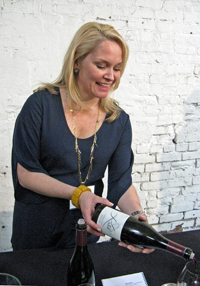 |
Kutch 2012 Pinot Noir, Sonoma Coast. Sourced from Sonoma Stage Vineyard in Petaluma Gap and Campbell Ranch near Annapolis, 100% whole-cluster fermented. Medium-light color, with bright red fruit, tea leaf / dried herbs, earth, and lots of spice on the nose. Medium weight with a smooth yet lively texture, finishing with moderate tannins.
Kutch 2012 Pinot Noir, Falstaff Vineyard, Sonoma Coast. The vineyard is near Freestone, planted to 115, 777, and 828 clones, and the fruit was fermented with 100% whole clusters. Medium-light ruby color, this featured pretty floral aromas along with cherry and raspberry, tea leaf, and spice. Medium-bodied with bright acidity and good structure for aging, finishing with slightly chalky tannins, nice.
Comments: Jamie Kutch’s first wine was from the 2005 vintage, and he’s worked exclusively with Pinot Noir from the start. Over the years he’s changed his winemaking style, having become more strongly influenced by the wines of Burgundy. The vineyard sources are mostly from the Sonoma Coast. Jamie and his wife Kristen Green were on hand to pour at the IPOB tasting, and the Falstaff Pinot was a standout.
LaRue Wines
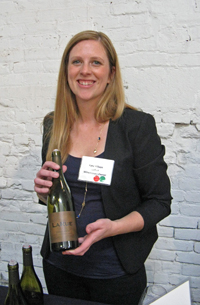 |
LaRue 2011 Pinot Noir, Sonoma Coast. Sourced from Rice-Spivak and Emmaline Ann vineyards, aged in 33% new French oak. Medium-light color, showing bright and earthy red fruits, dried herbs, baking spice, and a floral note on the nose. Medium-light bodied with a lively mouthfeel and moderate tannins with a stony mineral note on the finish.
LaRue 2011 Pinot Noir, Rice-Spivak Vineyard, Sonoma Coast. Medium-light ruby color, this displayed more intense strawberry and cherry fruit, plus tea leaf, a touch of forest floor, and plenty of spice. A bit bigger and more structured than the previous wine, with bright acidity and fine tannins – quite tasty now and should age nicely.
Comments: LaRue makes exclusively Sonoma Coast Pinot Noir. Owner/winemaker Katy Wilson (also the associate winemaker at Kamen Estate) launched the LaRue label with a Sonoma Coast Pinot from the 2009 vintage. Rice-Spivak Vineyard is located south of Sebastopol, while Emmaline Ann is near Freestone. She’s worked at a variety of noted wineries, including Craggy Range in New Zealand, Testarossa, and Flowers. Katy poured her wines at the event, and both Pinots were very good.
Matthiasson Wine
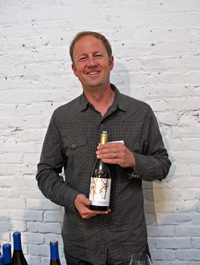 |
Matthiasson 2012 Chardonnay, Linda Vista Vineyard, Napa Valley. From a vineyard in the Oak Knoll area, the fruit was whole-cluster pressed and made in neutral oak with no malolactic fermentation. Light color, with bright citrus and green apple aromas along with fresh herbs. Lighter-bodied with a vibrant mouthfeel and crisp finish.
Matthiasson 2011 Chardonnay, Michael Mara Vineyard, Sonoma Coast. From a rocky vineyard site west of Sonoma, with fruit from both an early and late pick, made in neutral oak with 100% malolactic fermentation. Light straw color, this had stone fruit and a stony mineral element on the nose, plus a touch of spice in the background. Richer mouthfeel than the first wine but still lively and clean.
Comments: Steve Matthiasson is a highly-regarded viticulturist in addition to making wine, and he has an impressive list of clients, mainly in Napa. He and his wife Jill run the winery and produced their first commercial vintage in 2003. Not surprisingly, Steve is very hands-on when it comes to the farming of his vineyard sites. He was behind the table at the IPOB tasting. I’d tasted a couple of other very good Matthiasson white wines in the past, and trying these two Chardonnays showed his sure touch on that variety as well – both good and very different from each other.
Mount Eden Vineyards
Domaine Eden 2011 Pinot Noir, Santa Cruz Mountains. From Mount Eden’s property not far from their main estate vineyard, planted to 667, 777, 828, Calera, Mount Eden, and Swan clones, the wine was aged in 50% new French oak. Medium-light color, with earth and tea leaf aromas upfront, followed by red fruits, spice, and sweet oak. Medium weight on the palate, with a smooth texture and moderate tannins.
Mount Eden 2011 Pinot Noir, Estate, Santa Cruz Mountains. From the historic estate vineyard, 100% Mount Eden clone, made in 100% new French oak. Medium-light ruby color, featuring cherry and raspberry fruit, earth, smoke, a floral note, and a stony mineral component. Bigger and more structured than the Domaine Eden bottling, with chalky tannins on the finish – this will take time to show its best but holds plenty of promise.
Comments: Mount Eden is one of California’s most historic vineyard sites, with a story that extends back to legendary vintners Paul Masson and Martin Ray. The vineyard at Mount Eden was replanted beginning in 1984 with a variety of Dijon and “heritage” clones, including some propagated from the original vines planted there. Chardonnays are whole-cluster pressed and barrel-fermented in new and one-year old French oak, where they are aged on the lees for ten months, then bottle-aged for two years. Pinots undergo native yeast fermentations in small lots, then go into mostly new oak along with some one-year old oak, and barrel-aged for about 18 months. Proprietor/winemaker Jeffrey Patterson poured his wines at the IPOB tasting.
Native9 Wines / Alta Maria Vineyards
Alta Maria 2013 Pinot Noir, “Carbonic,” Santa Maria Valley. A new project from the winery, using Pinot clone 22 (“Gamay clone”), carbonic maceration and no malolactic fermentation. Light ruby color, bright and forward cherry and fresh herb notes on the nose. Lighter-bodied and lively on the palate with a clean finish – a fun take on Pinot Noir.
Alta Maria 2011 Pinot Noir, Santa Maria Valley. Fermented with about 15% whole clusters, aged in 20% new oak. Medium-light color, this had somewhat muted aromatics, with earth, spice, and darker fruit character. Medium weight with a fairly smooth mouthfeel and moderate tannins.
Native9 2011 Pinot Noir, Rancho Ontiveros Vineyard, Santa Maria Valley. Fermented with 85% whole clusters and aged two years in barrel. Slightly darker color, showing more intense dark fruit, earth, spice, tea leaf, and sweet oak aromas. A bit richer than the previous wine but very lively on the palate, with plenty of structure and a grippy tannic finish – like many 2011 Pinots, this will need time to develop.
Comments: Native9 Wines is the project of grower James Ontiveros – a ninth-generation Californian. His eight-acre vineyard in Santa Maria Valley was planted in 1997-2000 with a variety of Pinot clones, and the vineyard is farmed organically. Yields in the sandy vineyard site are low, generally around 1.25 tons per acre. The first release of Native9 Pinot Noir was in 2004, and the winemaker is Paul Wilkins. Typically a high percentage of whole clusters are used – often 100% – and fermentation is with native yeast. Both James and Paul were on hand to pour the wines at the tasting. While the Native9 Pinot will benefit from aging, the “Carbonic” Pinot is perfect for drinking now.
Peay Vineyards
Peay 2012 Chardonnay, Sonoma Coast. Sourced from Searby, Campbell, and the Peay estate vineyard. Light straw color, with apple and pear, spice, and touches of lemonpeel and sweet oak on the nose. Medium-light bodied, with a mildly creamy texture and smooth finish.
Peay 2012 Pinot Noir, Savoy Vineyard, Anderson Valley. Medium-light color, showing earth, forest floor, spice, and dried herbs, with black cherry and plum fruit in support. Medium-bodied with refined tannins on the finish.
Peay 2012 Pinot Noir, “Pomarium,” Estate, Sonoma Coast. Medium-light color, this featured pretty floral aromas along with strawberry fruit, tea leaf, and touches of earth and baking spice. A bit richer on the palate than the Savoy bottling with lively acidity and refined tannins, nice.
Peay 2012 Pinot Noir, “Scallop Shelf,” Estate, Sonoma Coast. Not yet released. Slightly darker color, this also displayed a darker fruit profile with stronger earth and spice components. More structured in the mouth with bolder tannins on the finish – this will need more time to develop than the “Pomarium,” though both should age nicely.
Cep 2013 Pinot Noir Rosé, Hopkins Ranch, Russian River Valley. From fruit picked early and pressed specifically for Rosé (not saigneé), made in stainless steel. Very light pink color, with bright strawberry aromas, vibrant acidity, and a crisp finish.
Comments: Peay Vineyard is located only about four miles from the ocean in the far northwest reaches of the Sonoma Coast AVA near the town of Annapolis. The Peay label is run by the husband-and-wife team of Nick Peay, who farms the vineyard, and Vanessa Wong, who makes the wine, and by Nick’s brother Andy, who handles the marketing and sales work. All three were there at IPOB this year. The first estate plantings were in 1998, and currently include 34 acres of Pinot Noir and 7 acres of Chardonnay within the 51-acre vineyard, which is farmed organically. Many of the Peay wines are made entirely from estate fruit, though some include purchased fruit as well. This was a good showing for the Peay wines.
Red Car Wine Company
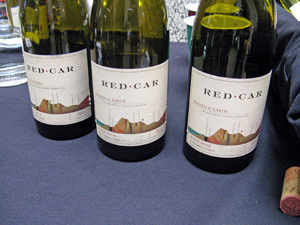 |
Red Car 2012 Chardonnay, Sonoma Coast. Sourced from Weeks, Ritchie, Hawk Hill, and Zephyr Farms vineyards, mostly Old Wente clone, aged in 10% new oak. Light straw color, showing pear and lemonpeel, along with notes of flowers and earth. Medium-light weight in the mouth, with a bright texture and crisp finish.
Red Car 2012 Chardonnay, Estate Vineyard, Fort Ross-Seaview. Slightly darker yellow-straw color, this had more intense aromas of stone fruit and tangerine, plus spice and a slightly saline character. Medium-bodied with a creamier mouthfeel than the previous wine, and a clean finish – nice now but should be even better with some time in the cellar.
Red Car 2012 Pinot Noir, Platt Vineyard, Sonoma Coast. From a vineyard between Freestone and Bodega, with Calera, 777, and 828 clones. Medium-light ruby color, with earth, spice, and floral notes along with black cherry fruit. Medium-light bodied and lively on the palate, with round tannins on the finish, nice.
Red Car 2011 Pinot Noir, Zephyr Farms Vineyard, Sonoma Coast. From a vineyard just outside Freestone. Slightly darker color, this displayed more forward raspberry and plum fruit, plus earth and baking spice components. Bigger and more structured than the Platt bottling, with plenty of bright acidity and slightly chalky tannins.
Comments: Red Car was established in 2000 by Carroll Kemp and Mark Estrin, who passed away in 2005. Carroll continues to head up the label and the winemaking, and he was on hand to pour his wines at IPOB. Originally located in Santa Barbara County and focused on fruit from that area, Red Car moved to the Sonoma Coast in the mid-2000’s, planting an estate vineyard on King Ridge, north of Hirsch Vineyard in the Fort Ross-Seaview AVA. The style of Red Car’s wines has evolved considerably along with the change in vineyard locations, and Carroll poured a strong group of wines across the board.
Sandhi Wines
Sandhi 2012 Chardonnay, Santa Barbara County. Sourced from Sta. Rita Hills, Santa Maria Valley, and Santa Ynez Valley, from vines averaging over 25 years old, barrel-fermented. Light yellow-straw color, with apple and pear, spice, and a touch of oak on the nose. Medium-bodied, this had a creamy texture but with lively acidity and finish.
Sandhi 2012 Chardonnay, Sta. Rita Hills. Vineyard sources include Rita’s Crown, Bentrock, and Wenzlau, made in 20% new oak. Light color, this had a more earthy character than the previous wine, plus stone fruit and tropical fruit notes, spice, and toasty oak in the background. Richer mouthfeel than the previous wine, with a chalky mineral note on the finish.
Sandhi 2012 Pinot Noir, “Amrita,” Wenzlau Vineyard, Sta. Rita Hills. Made with 100% whole cluster by carbonic maceration and no added sulfur. Medium-light ruby color, featuring pretty floral aromas upfront, along with black cherry and plum fruit and dried herbs. Medium-light bodied with a fairly round texture and milder tannins – not sure if I’d risk aging it for long but there’s little need since it’s so tasty right now.
Sandhi 2012 Pinot Noir, Rinconada Vineyard, Sta. Rita Hills. Slightly darker color, showing a riper and darker fruit profile than the previous wine, along with herb and earth notes. Richer on the palate, with good structure and moderately grippy tannins.
Comments: Sandhi was established in 2010 by IPOB co-founder Rajat Parr, wine director for Michael Mina Restaurants, Charles Banks, former owner of Jonata and Screaming Eagle, and winemaker Sashi Moorman. The first wines released were from the 2009 vintage, and most of the winery’s fruit comes from the Sta. Rita Hills AVA. The climate and the diatomaceous soil found in part of that region were factors in choosing these vineyard sources. Chardonnays are crushed and pressed to tank, then racked straight to mostly older cooperage for fermentation and aging. Pinots are mostly fermented with whole clusters, and all of the wines are fermented with native yeast. Raj poured his wines at the tasting, and I particularly liked the “Amrita” bottling with no added sulfur.
Wind Gap Wines
Wind Gap 2010 Chardonnay, Sonoma Coast. Sourced from Gap’s Crown and Obsidian vineyards and made in neutral French oak. Light color, showing pear and stone fruit with touches of lees and wet stones. Medium weight with a creamy texture and a fairly smooth finish.
Wind Gap 2012 Chardonnay, Woodruff Vineyard, Santa Cruz Mountains. Light straw color, this featured citrus, earth, orangepeel, and spices. Lively mouthfeel with bright acidity and a chalky mineral quality on the finish, nice.
Wind Gap 2012 Pinot Noir, Woodruff Vineyard, Santa Cruz Mountains. 100% whole-cluster fermentation. Medium-light ruby color, with tea leaf, earth, and lots of spice upfront and red cherry fruit in support. Nice texture on the palate with a slightly resiny note on the grippy tannic finish.
Wind Gap 2012 Pinot Noir, Sonoma Coast. Sourced from Gap’s Crown, Griffin's Lair, Black Knight, and Sun Chase vineyards, fermented with 25% whole clusters, and aged for 12 months in concrete and in neutral French oak. Medium-light color, displaying slightly floral aromas plus plum and black cherry fruit and spice on the nose. Richer mouthfeel than the previous wine, with moderate tannins.
Comments: Wind Gap is the label of Pax and Pam Mahle, founded in 2006. The winery is moving into The Barlow, a complex of new and renovated buildings on the eastern edge of downtown Sebastopol. A number of the Wind Gap vineyard sources are from areas where coastal breezes help shape the growing season – the noted Petaluma Gap is just one example. Fermentations are with native yeast, and Pinots generally include a good deal of whole clusters. The fermentation and aging is done in various vessels – stainless steel, concrete, and older oak. As usual, Pax was behind the table at the IPOB tasting. Both the Chardonnay and the Pinot from Woodruff Vineyard were distinctive, with the Chardonnay being a favorite.
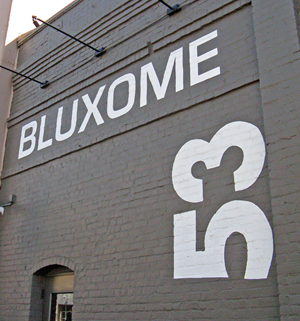 |
|


